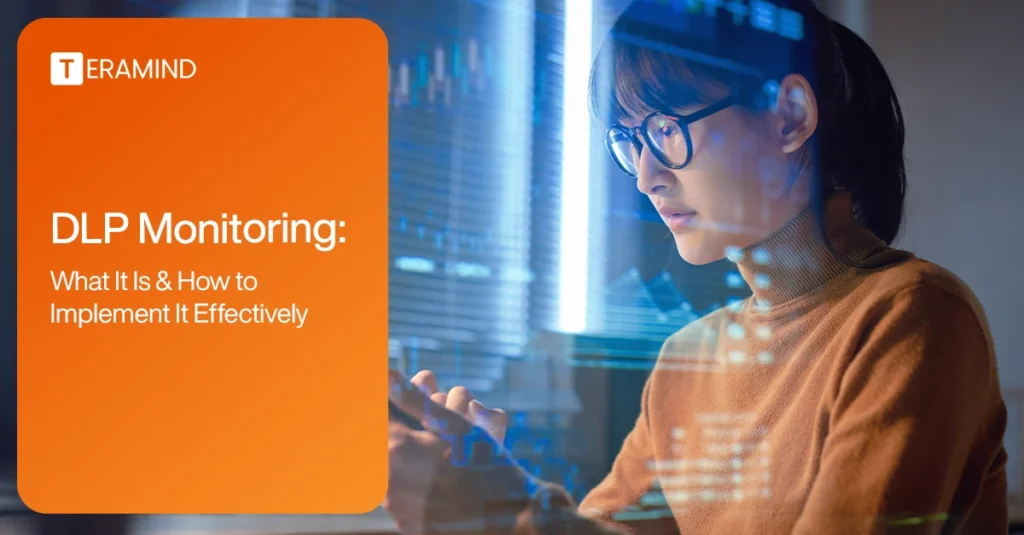Data loss prevention (DLP) is one of the most important things your organization can do to avoid being in the headlines for the wrong reasons. By investing in DLP monitoring, you take crucial steps to prevent data breaches and stop unauthorized users from accessing corporate and customer data.
In this article, we’ll cover everything you need to know about DLP monitoring, including why it’s important and how to implement it successfully. We’ll also explore common challenges with compliance solutions and DLP developments that are already making this technology even more effective.
What is DLP monitoring?
DLP monitoring is the process of observing and analyzing data usage and movement throughout an organization by scanning corporate networks, the cloud, and endpoints in real time. The main goal is to prevent unauthorized access and data breaches that could compromise sensitive information or create security risks.
With DLP monitoring, you track data access, usage, and transfer to identify security risks and policy violations. DLP technology uses advanced algorithms and machine learning to spot unusual behavior and abnormal activities so you can address any issues before they escalate.
Key components of DLP monitoring
To create a successful DLP monitoring strategy, you need a few components. Data discovery and classification tools help identify sensitive information across the organization and categorize it by risk level. Content inspection engines analyze data in motion, in use, and at rest.
Once you have data handling regulations in place, you need policy enforcement mechanisms to ensure compliance. And to address and document security events like data breaches and leaks, you need incident response and reporting capabilities.
Types of data protected by DLP monitoring
With a DLP monitoring solution, you can protect data that pertains to employees, customers, and your organization. Here are some of the most common types of data these solutions monitor:
- Personally identifiable information (PII) like end users’ social security numbers and credit card details
- Intellectual property (IP) like your company’s trade secrets, product designs, and source code
- Healthcare information and medical records that are protected by HIPAA regulations
- Financial data like your organization’s bank account information and investment strategies
Why DLP Monitoring Is Essential for Your Business
DLP monitoring is critical for businesses in virtually every industry. It can protect organizations from both internal and external threats, making it an essential line of defense.
Mitigating insider threats
It’s easy to assume that external hacks or cyber attacks are most likely to compromise your organization’s data security. But in many cases, the call is coming from inside the house. Malicious insider breaches can present a serious risk to your organization.
That’s why DLP monitoring focuses on identifying suspicious user activity from employees or contractors. These tools detect unauthorized attempts to access, copy, or transfer sensitive data. As they analyze data usage patterns, DLP tools flag unusual behavior for further investigation, addressing threats before they escalate.
Ensuring regulatory compliance
All organizations are vulnerable to data breaches and leaks. However, a data leak can create serious consequences for organizations with strict data protection requirements like HIPAA, GDPR, and CCPA.
DLP monitoring enforces data handling policies, which helps maintain compliance with these government regulations. DLP systems also provide audit trails so organizations can demonstrate adherence. Plus, their use of automation reduces the risk of human error in compliance management.
Protecting against external threats
Many DLP systems also scan for external threats to prevent data exfiltration attempts by malicious actors. They look for vulnerabilities in security infrastructure so organizations can take preventive measures.
As they monitor data movement through the organization, DLP systems can identify signs of advanced persistent threats (ATPs). With continuous monitoring, they enable quick responses to emerging security threats and attempted data breaches.
How to Implement Effective DLP Monitoring
Implementing a DLP monitoring solution requires a three-part process. You need a comprehensive data loss prevention policy, the right DLP solution, and ongoing employee training.
Develop a comprehensive DLP strategy
Start by conducting a thorough risk assessment. Identify your organization’s critical data assets and potential vulnerabilities. With this information in hand, create a data classification framework data based on sensitivity. Then, develop data handling policies for each information category.
Next, establish key responsibilities within your organization, keeping in mind that. DLP monitoring isn’t just an IT issue. Instead, IT, HR, legal, and security teams should all have a role in the process. Involve these team members as you create incident response plans for addressing policy violations and potential data breaches.
Choose the right DLP monitoring tools
When you evaluate DLP monitoring solutions, one of the most important factors to consider is compatibility with your existing IT infrastructure. Based on your organization’s existing setup, you might consider a cloud monitoring solution or an on-premises system.
Any data loss prevention software you choose should provide comprehensive coverage across your organization. This includes cloud computing environments, corporate networks, and endpoint devices.
Ideally, you also want a system that continues to improve over time. Seek out a monitoring solution that offers improved threat detection via advanced user behavior analytics and machine learning capabilities.
Train teams and improve employee awareness
As you roll out your chosen software solution, take time to educate employees about your organization’s data protection policies. Highlight the importance of data security and individual responsibilities by creating awareness campaigns and employee training sessions.
After implementing the solution, provide regular updates and training on emerging threats, best practices, and company policies for data handling. Aim to encourage a culture of security awareness throughout the organization.
How to Overcome DLP Monitoring Challenges
While implementing a DLP solution is a relatively straightforward process, it may present some challenges. Watch for these common issues to prevent protective actions and tools from slowing down your organization.
Balance security and productivity
Any DLP monitoring solution you choose should keep your organization’s data secure without compromising your team’s productivity. However, some solutions tend to be overly sensitive, triggering unnecessary alarms or impeding workflows.
To strike the right balance, seek out a DLP monitoring tool that creates minimal disruptions to your normal business operations. Rather than using pattern matching alone, use contextual analysis to understand the reason for the data usage and reduce false positives. In many cases, it’s also helpful to fine-tune your organization’s data policies. By adjusting monitoring rules, you can maintain the optimal balance between security and efficiency.
Handle encrypted data
Malicious actors may use encrypted data to breach your organization’s security measures. As a result, it’s important to choose a solution that can inspect encrypted data without compromising security.
To resolve this issue, consider using secure sockets layer or transport layer security (SSL/TLS) technology as a strategy to monitor encrypted data. You’ll also need to establish policies to handle encryption keys and certificates within the DLP monitoring framework to avoid creating security or compliance issues.
Address privacy concerns
Because DLP monitoring systems observe and analyze data movement throughout the organization, some may raise privacy concerns. As you implement this technology, ensure your monitoring practices comply with any local, national, or industry-specific privacy laws and regulations.
One of the most important boxes to check is creating an audit trail for any DLP monitoring activities. You’ll also want to develop clear policies on how DLP systems collect, use, and retain data.
It’s just as important to keep employee concerns in mind as you implement DLP monitoring. Communicate with staff about how and why you’ll monitor their activities to set appropriate expectations.
The Future of DLP Monitoring
Between identifying anomalous activity, analyzing endpoint actions, and detecting cyber threats, data loss prevention tools are already incredibly advanced. However, new developments make the future of these systems appear even more promising for preventing potential threats.
Integrations with AI and machine learning
DLP monitoring systems increasingly use AI to enhance threat detection by spotting when users engage in abnormal activity. With AI, these tools can also consider context, which helps reduce false positives.
Machine learning technology allows these tools to identify new patterns of unauthorized access to systems or data usage, which helps with identifying and preventing external or internal threats. With these predictive analytics, organizations can identify emerging data security risks and adapt to evolving threat landscapes.
Adaptations for evolving work environments
Without effective tools, monitoring remote and hybrid employees can be difficult. However, cloud-based systems can simplify DLP monitoring across an array of tools, devices, and network environments.
These systems act as endpoint protectors, setting access controls, monitoring file transfers, and creating alerts on activity that doesn’t comply with the organization’s data handling policies. Some also offer remote desktop control when automated responses and alerts don’t prompt users to change their behavior.
Enhanced incident response capabilities
From accidental data loss to giant data breaches, security issues of any size can create substantial problems. One of the most effective ways to mitigate risk is to integrate DLP monitoring with broader incident response frameworks.
This approach gives organizations more complete visibility into data and access issues, reducing mean time to detect (MTTD). Real-time alerts and automated response mechanisms can lower mean time to respond (MTTR), which can decrease the severity of data security incidents.
Teramind: A Comprehensive DLP Monitoring Solution
With Teramind, you can strengthen data security throughout your organization. Our data loss prevention solution provides a robust DLP monitoring system that also solves for the human element.
Key features of Teramind for DLP monitoring
Teramind gives organizations an array of tools to detect and prevent data loss in real time. Our DLP solution With our DLP solution, you can easily create data handling policies and enforce compliance. Teramind can:
- Track website and app usage to prevent employees from sharing data via messaging, social media, or AI apps
- Monitor online meetings on any platform, including information like participants, duration, and content
- Log keystrokes across applications to create a searchable content index your team can analyze
- Take time-stamped screen recordings so you can see the context around any security incident
- Provide optical character recognition (OCR) capabilities to identify text in screenshots and documents
Customization and scalability
With Teramind, you aren’t stuck with a one-size-fits-all solution. Instead, you can tailor its policies and responses to meet your needs. For instance, you can set up smart rules to warn, block, or lock out users who perform specific high-risk actions.
Whether your organization prefers a cloud-based or on-premises solution, Teramind has a deployment model that fits your needs. And because our platform can support anywhere from five to 200+ seats, it’s ideal for growing businesses and enterprises.
Teramind’s approach to user privacy and ethical monitoring
Teramind takes a privacy-first approach to monitoring. We designed our privacy controls and data anonymization features to promote transparency, encourage trust, and allow for ethical monitoring. Organizations can opt to limit recordings to rule violations and surrounding activity to preserve privacy.
Our approach to DLP monitoring also complies with global privacy regulations. As a result, our DLP solution protects sensitive information while also ensuring your organization adheres to data privacy guidelines.
Conclusion
Data breaches have the potential to create serious risks for any organization. From insider threats to external actors, data leaks can lead to reputation issues, financial concerns, and an inability to meet compliance requirements.
With a DLP monitoring solution like Teramind, you can take steps to mitigate these risks and improve data security throughout your organization. By monitoring employee activity, you can successfully spot high-risk activities, respond automatically in real time, and enforce compliance.



